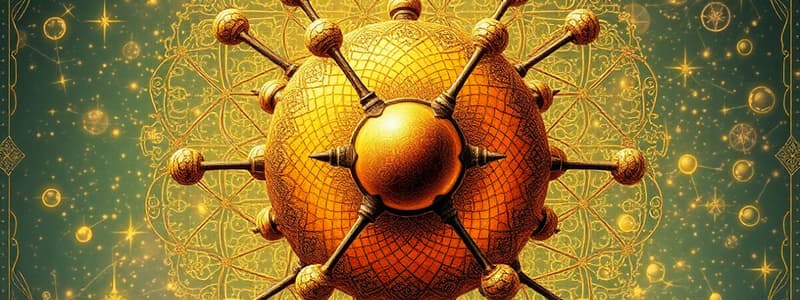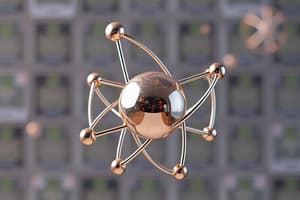Podcast
Questions and Answers
What does the period number signify in the context of atomic structure?
What does the period number signify in the context of atomic structure?
- The atomic mass of the element
- The number of shells surrounding the atom (correct)
- The number of electrons in the outer shell
- The number of protons in the nucleus
Which statement about noble gases is true?
Which statement about noble gases is true?
- They are highly reactive due to their incomplete valence shells.
- They have full valence shells and do not bond with other elements. (correct)
- They readily bond with other elements.
- They tend to lose electrons during chemical reactions.
How does metallic character change in the periodic table?
How does metallic character change in the periodic table?
- It increases diagonally upwards and to the left.
- It increases diagonally downwards and to the right. (correct)
- It is constant across the periods.
- It decreases diagonally downward and to the right.
What characterizes atoms in the same group of the periodic table?
What characterizes atoms in the same group of the periodic table?
What is the maximum number of electrons that a valence shell can hold?
What is the maximum number of electrons that a valence shell can hold?
Which statement best describes the contribution of Rutherford to atomic theory?
Which statement best describes the contribution of Rutherford to atomic theory?
What did Niels Bohr add to the atomic model in 1913?
What did Niels Bohr add to the atomic model in 1913?
Which of the following is true about electrons in an atom?
Which of the following is true about electrons in an atom?
How did John Dalton's atomic theory describe atoms?
How did John Dalton's atomic theory describe atoms?
What role do neutrons play in an atom according to Chadwick's discovery?
What role do neutrons play in an atom according to Chadwick's discovery?
What do we call substances consisting of only one kind of atom?
What do we call substances consisting of only one kind of atom?
Which of the following represents the correct capacity of electron shells?
Which of the following represents the correct capacity of electron shells?
What did Democritus theorize about atoms in 400BC?
What did Democritus theorize about atoms in 400BC?
What characterizes a negative ion?
What characterizes a negative ion?
What is the correct way to represent the ion formed by calcium?
What is the correct way to represent the ion formed by calcium?
What element group includes all the alkali metals?
What element group includes all the alkali metals?
What does the atomic mass represent?
What does the atomic mass represent?
What is true about noble gases?
What is true about noble gases?
Which scientist is known for arranging elements into the periodic table?
Which scientist is known for arranging elements into the periodic table?
How did John Newlands categorize elements?
How did John Newlands categorize elements?
What is the term for the elements found along the zigzag line on the periodic table?
What is the term for the elements found along the zigzag line on the periodic table?
What happens to an atom when it gains electrons?
What happens to an atom when it gains electrons?
What is the characteristic of atoms with the same atomic number?
What is the characteristic of atoms with the same atomic number?
Flashcards are hidden until you start studying
Study Notes
Period Number in Atomic Structure
- The period number indicates the principal energy level, also referred to as the electron shell, of an atom's outermost electrons.
Noble Gases
- They are found in Group 18 of the periodic table.
- They have a full outer shell of electrons, making them unreactive.
Metallic Character
- Increases down a group and decreases across a period of the periodic table.
- This pattern is due to the decreasing ionization energy down a group and increasing ionization energy across a period.
Atoms in the Same Group
- They have the same number of valence electrons, which are the electrons in the outermost shell.
- This shared characteristic explains their similar chemical properties.
Maximum Electrons in Valence Shell
- The maximum number of electrons that a valence shell can hold is eight, in accordance with the octet rule.
Rutherford's Contribution to Atomic Theory
- He discovered the nucleus of the atom and proposed a model where negatively charged electrons orbit a positively charged center.
Bohr's Addition to the Atomic Model
- He described the quantized energy levels of electrons, meaning electrons can only exist in specific energy levels.
- He introduced the concept of electron orbitals, representing regions of space where electrons are likely to be found.
Electrons in an Atom
- They carry a negative charge.
- They are constantly moving around the nucleus, forming a cloud rather than a specific orbit.
John Dalton's Atomic Theory
- He proposed that atoms were indivisible and indestructible particles.
- He also described atoms as identical for a given element.
The Role of Neutrons
- They are neutral particles found in the nucleus of an atom.
- They contribute to the mass of the atom but not to its charge.
Substances with One Kind of Atom
- These substances are called elements.
Capacity of Electron Shells
- The first shell can hold a maximum of two electrons.
- The second and third shells can hold a maximum of eight electrons.
Democritus' Theory About Atoms
- He proposed that matter is composed of indivisible and indestructible particles which he called atoms.
Negative Ion
- An atom that gains electrons becomes negatively charged, creating a negative ion also known as an anion.
Calcium Ion
- The correct representation is Ca²⁺.
Group of Alkali Metals
- Group 1 contains all the alkali metals.
Atomic Mass
- It represents the average weight of all isotopes of an element.
Key Facts About Noble Gases
- They are colorless and odorless gases at room temperature.
- They are extremely unreactive, due to their full outer shell of electrons.
The Person Who Arranged the Periodic Table
- Dmitri Mendeleev is credited with the arrangement of elements into the periodic table.
John Newlands' Categorization of Elements
- He categorized elements based on their increasing atomic mass.
- He identified patterns of repeating chemical properties every eight elements, known as the Law of Octaves.
Elements Along the Zigzag Line
- They are called metalloids.
- They possess properties of both metals and nonmetals, displaying semiconducting behavior.
Atom Gaining Electrons
- When an atom gains electrons, it becomes a negative ion, also known as an anion, due to the increased negative charge.
Atoms with the Same Atomic Number
- They are classified as the same element, because the atomic number defines the number of protons in the nucleus, which is the defining characteristic of an element.
Studying That Suits You
Use AI to generate personalized quizzes and flashcards to suit your learning preferences.




